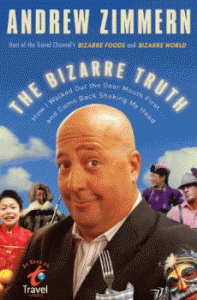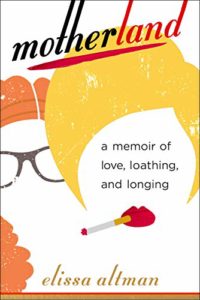A Conversation with Andrew Zimmern
I‘ve been a fan of food television for as long as I can remember; for better or for worse, the hours I’ve logged watching Lidia and Jacques, Julia and the Tamales, Keith Floyd and Mario, the Fat Ladies and Nigella and Jamieand Tony —they are many, indeed. And while I think the actual Food Network is a nice idea, I tend to lean heavily towards those television folk who make the inextricable link between gastronomy and anthropology, and then breathe a kind of Mutual of Omaha’s Wild Kingdom, you-are-there life into it. And no one does it better than Andrew Zimmern–television star, anthropologist, chef, author of the amazing The Bizarre Truth, devoted husband, loving dad, and all around good guy.
Of course, one doesn’t have to be Marshall McLuhan to understand that Andrew was probably positioned by his network as a big, cute bald guy who eats bad-ass bugs; sure, he does that, and there’s a heck of a lot of marketing bang for the buck there. But Andrew does a hell of a lot more. If you look beyond the maggots and the roasted roaches and the things that would make Sandra Lee drop a kidney where she stood, you’ll find something and someone else: a deeply astute culinarian who loves people, and who has made it his life’s work to understand other cultures by eating their food on their turf, whether it’s smack dab in the middle of a war zone, in deepest Mongolia, in the hills of Cass County West Virgina, or at a Beijing restaurant that serves only penis. What he asks of us is that we open our minds and hearts the same way: by breaking bread with others—maybe even the last people on earth we’d ever think to sit down and share a meal with. And nothing will ever be the same.
Andrew took time out of his busy schedule to speak with me recently, and we started exactly where two Jewish New Yorkers typically begin: with Chinese food.
You and I are pretty much the same age, and we were born and raised in the same place in very similar circumstances. So be honest: Is your apparent obsession with Chinese food tied directly to the fact that you’re a nice boy from New York who grew up a self-admitted “dumpling freak?” I mean, why not kreplach?
Because despite my Hebe-ness, a Shanghai soup dumpling beats kreplach out every day of the week. Growing up we ate Chinese food twice a week, at least, and every Sunday evening was a special night at Richard Mei’s King Dragon. My obsession is two fold.
One: Chinese food, real Chinese food, with steamed dishes, fried, wok tossed, cold plates, salads and so on is one of the most complex and sophisticated food styles in the world. I adore it. Second: wait, there isn’t a second. I also think that Chinese food exploded in popularity in New York City during my culinary coming of age, the regional Chinese movement that is. I ate Lettuce Package at Bo-Bo’s, spicy tiny dried fish salad at the original David K’s, almost got arrested in 1986 in Mr Chows in Beverly Hills, was at opening night at Pig Heaven and at Uncle Tai’s, and have eaten Spicy Slippery Chicken at the first Szechuan Kitchen. Between that and the food trips I have taken into the People’s Republic of China and Taiwan, and even in Chinatowns in San Francisco, London and Bangkok, I guess you could say I am still an active addict.
Here comes the love: I’ve been a fan of yours from the get-go, and it only took me one episode (I’ve referred to it as the Member’s Only show—you figure it out) to realize that what you do is very much not about eating bugs, or the value of shocking the viewer; it’s all about local food, culture, and bridging gaps. How did this interest in culinary anthropology begin for you?
With my dad. Sitting in a sleepy Les Halles bistro and picking bigorneaux with your dad sounds pretentious but its how we lived. I traveled and ate my way around the world with him by the time I was 13. It worked. Eating angulas and milk fed baby piglet in Madrid at age 10 left an impression. And then when I saw the same dish syncretically offered elsewhere I was shocked and appalled at the lack of quality. That doesn’t mean only Chinese people can make good Chinese food, and it doesn’t mean that all authentic food is good, but it does mean that having tasted a dish in its terroir and connecting the stories of the culture to the dish heightens the experience.
Recently, I wrote an article that ended with my saying that until eating sustainably becomes “just the way we live” and “nothing special,” it will remain little more than a trend (and as we know, trends die). Wherever you go, you seem to always find yourself experiencing cultures that use absolutely everything; nothing ever goes to waste. Are we westernized nations always going to be burdened with the two-edged sword of “plenty?” Are we destined to be a culture of culinary consumerists, where more is better and the All-You-Can Eat buffet continues to be prized? How do we change that?
It won’t change for the majority of Americans, but its important that we do all we can to change it for as many as we can change it for. It won’t die, and I think in the last year it has outgrown trend status, but I believe in following the money to see the truth. And the truth is that so many big companies, and government drones and so many of us have so much invested in the system that you can’t scrap it. But scrapping it would be in everyone’s interest. Our two edged sword of plenty is pretty nice in many other respects. For me the biggest crime is that we have made eating well and eating wisely a class issue in America. If you are time poor or cash poor, you are fucked. That’s a crime. I also think that we have some pretty big issues to solve that are more important than the food issues, energy and education being two of them. I also agree with my friend Tony Bourdain who most famously opined what many of us feel strongly about which is that feeding our kids organically and sustainably in schools is great, but let’s teach them to read and write first and foremost. The food issue is akin to the Katrina story cycle in the sense that until a disaster of gripping proportions is made more public (its going on, we just don’t hear about it…anyone care to show your kids pictures of the local abbatoir?) no one will have the stomach to change the reality that Americans have the worst food habits on the planet…oh and our food system has been dangerously compromised and is in fact killing people. You and I know that, but ask the average American and they will blithely order a second KFC Double Down.
You often find yourself traveling during what can easily be described as precarious political times. And even though I’ve always said that people need to just break bread together instead of killing each other, that’s clearly an oversimplification. I recall Tony Bourdain being in Beirut during the 2006 Israeli-Lebanese conflict, and I remember reading about your being in Morocco when Abu Musab al-Zarqawi was killed; such events turn culinary hot spots into war zones, and you from food journalists to potential battle correspondents. I don’t think a lot of people realize that. Do you prepare differently for visits to potentially dangerous regions than you do to less politically or violently-engaged areas? Or, when it comes to food, are people just people?
We do prepare a lot, and have security in many of these hot-zones. But I just came back from Syria, and in rural Syria being an American Jew in the TV business was potentially scary for me. It turned out to be a canard. The Syrians are the friendliest people I have met in years. Now, the night I spent in Jeppys in Johannesberg was a different story. People were coming up to me to touch my skin because they never saw a white person in their building before. That was an important story to tell. People warned us not to go there, but where else but in Jo-bergs most notorious slum could you find Zulu men teaching each other to dance and turning out some pretty impressive grilled goat?
Quick question: Aged Nicaraguan Chontales, or Canard a la Presse at Rostang’s in Paris?
Well on the face of it you would say the duck, but the cheese was artisanal and delicious and served with perfect local fruit….i loved it despite the live maggots. Okay, I’ll admit the duck was pretty killer. I happen to believe that pop music is as valid as symphony, and that watching my son play baseball is as fun as watching a Twins-Yanks double header so I will have to defend both maggot infested cheese and 3-star Guide Michelin chefs with equal intensity.
You probably get this a lot, but I’d be remiss: tell us about your most memorable meal, and your favorite meal. Are they the same?
Memorable meals have become sadly diluted for me. in a period of a few months I literally dove for Rainbow Crays on the Barrier Reef, ate lobsters off the coast of Maine with Linda Greenlaw, hunted antelope in the South African Veldt and ate in Adria’s kitchen. I have had breakfast with Herve This, lunch with Gagnaire and dinner withRostang in the same day and it wasn’t even the best meal I had that day (L’ami Jean beat them all). I have been blessed with eating in the kitchens of almost every restaurant that food freaks hold in high esteem and eaten in all the places with amazing food that no one knows exits. Those are the ones I adore most. The teeny little hovel in the steppes of Mongolia where I ate lamb dumplings in horse mares milk yogurt, the islands in the pacific where tuna collars are glazed with raw sugar, soy and rice wine while they roast over coconut shells, the fish markets in Okinawa, laksa stalls in Singapore, spring roll hawker tables in Hanoi, BBQ pork vendors in Malaysia or Puerto Rico…but the most memorable meals are the family dinners we have in every show, usually offered by people who can’t afford to feed themselves regularly, let alone care for guests. Their generosity has been and continues to be humbling. The Mayan family in Belize and their Easter meal of pig head tamales is right up there, so is the Juntwazee giant porcupine grill-out with a wild honey chaser in the Aha Hills of the Kalahari outside of Xai Xai. Eating giant clams in Samoa with the local Matai. Those are the most memorable.
My favorite meal is easy: it’s the one I have every two weeks when I come back home from a grueling road trip and eat tater tot hot dish with my wife and son on our back screen porch.
What do you do when you find yourself on the receiving end of literally too much food? I recall a thirty-six course, multi-hour bacchanal in Delhi that left you oozing lamb from your pores “for days.” Is it ever okay to say no?
Worse than that Wazwan meal are the days spent eating market fare from dawn to dusk where I swear I eat 15 pounds of food. Its an awful burden. Truly.
What is next on the map for you? Will you start introducing your son to your culinary anthropology, or is it already in his blood? What is his—and your—favorite meal to prepare at home?
Next up are some new books, a board game, a new season of Bizarre Foods, a new season of Appetite for Life, my Toyota-sponsored web series on MSN.com, hopefully a vacation, the usual. Noah loves to eat everything from Korean soup bowls to tacos de cabeza to Szechuan Dan Dan noodles. He’s a Zimmern for sure. We cook a lot as a family and our go-to meal that we all love is to make some home-made coleslaw, steam some corn and eat piles of these real crab cakes. We sauce them at the table with lemon-mayo and pass around the Crystal hot sauce.
 New England Style Crab Cakes
New England Style Crab Cakes
1/2 c. mayonnaise
1 large beaten egg
1 T. Dijon mustard
1 T. Worcestershire sauce
A dash of Crystal hot sauce
1 lb. Jumbo lump crabmeat, picked over…get the best stuff you can get your hands on!
20 saltines
1/4 cup canola oil
Whisk together mayo, egg, mustard, Worcestershire sauce and hot sauce.
Put crabmeat in a large bowl. Coarsely crush crackers over crabmeat.
Pour mayo mixture over crabmeat mixture and gently fold ingredients together.
Chill crabmeat mixture for at least 1 hour minutes. Form into 8
packed mounds. Saute in the canola oil over medium high heat in a large saute pan until browned on both sides. Drain on paper towel. Makes 8 cakes.
Delicious, Andrew—thank you!




